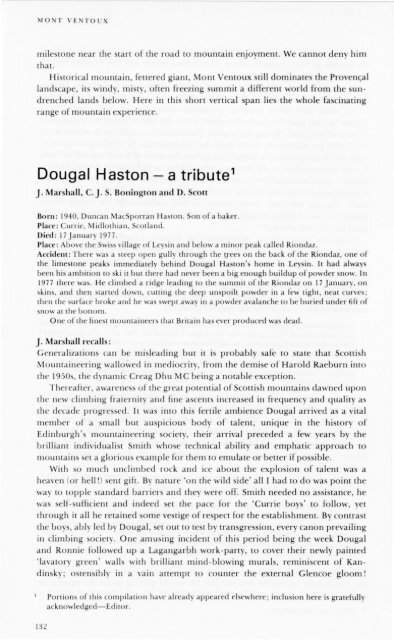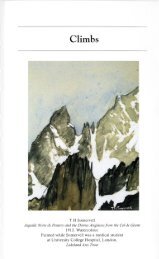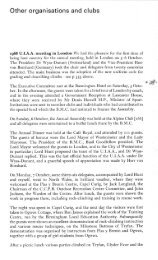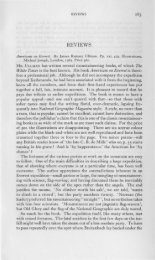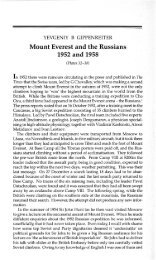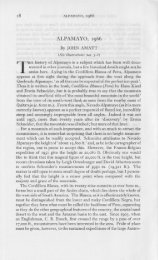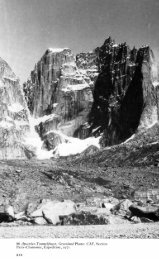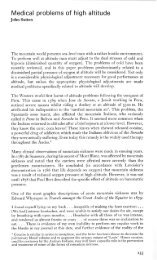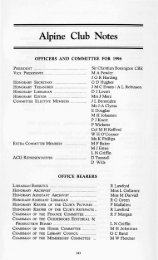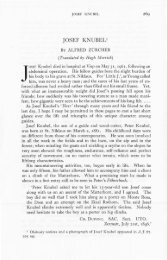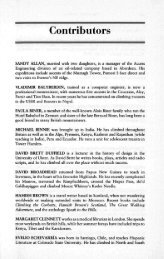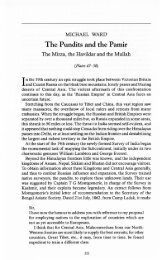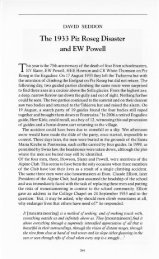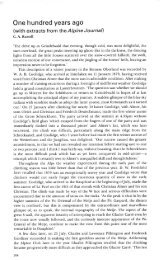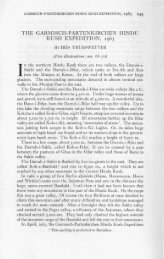Dougal Haston - a tribute1 - Alpine Journal
Dougal Haston - a tribute1 - Alpine Journal
Dougal Haston - a tribute1 - Alpine Journal
You also want an ePaper? Increase the reach of your titles
YUMPU automatically turns print PDFs into web optimized ePapers that Google loves.
MONT ENTOUX<br />
milestone near the tart of the road 10 mountain enjoyment. We cannot deny him<br />
thal.<br />
HistOrical mountain, fenered giam, Mont VentOux still dominates the Provenr;al<br />
landscape, its windy, mi ty, often freezing ummit a different world from the sundrenched<br />
lands below. Here in this short vertical span lies the whole fascinating<br />
range of mountain experience.<br />
<strong>Dougal</strong> H aston - a tribute 1<br />
J. Marshall, C. J. S. BoninglOn and D. Scott<br />
Born: 1940. Duncan Mac porran Ha IOn. on ofa baker.<br />
Place: Currie, Midlothian, colland.<br />
Died: 17 January 1977.<br />
Place: Above the Swi village of Le in and below a minor peak called Riondaz.<br />
Accidel1l: There was a steep open gully through rhe trees on the back of the Rjondaz, one of<br />
the limestone peaks immediately behind <strong>Dougal</strong> HasLOn's home in Leysin. It had always<br />
been his ambition to ski it but there had never been a big enough buildup of powder snow. In<br />
1977 there was. He limbed a ridge leading to the summit of the Riondaz on 17 January, on<br />
kin, and then staned down, cuning the deep un poilr powder in a few tight, neat curves;<br />
then the surface broke and he was s\vept awa in a powder avalanche to be buried under 6ft of<br />
snow at Ihe bOllom.<br />
One ofthe fine t mountaineer that Britain has ever produced was dead.<br />
J. Marshall recalls:<br />
Generalization an be misleading but it i probably afe to tate thal Scottish<br />
Mounrainecring wallo\ved in mediocrity, from the demise of Harold Raeburn intO<br />
the 1950s, the dynamic Creag Dhu M C being a notable exception.<br />
Thereafter, awat'ene s of the great potential orScollish mountains dawned upon<br />
the new climbing fraternity and fine a cents increased in frequent;y and qualiry a<br />
Ihe decade progressed. It was into this fertile ambience <strong>Dougal</strong> arrived a a ital<br />
member of a small but auspicious body of talent, unique in the hi wry of<br />
Edinburgh's mountaineering society, their arrival preceded a few year by the<br />
brilliant individualist mith whose technical ability and emphatic approach to<br />
mountains et a glorious example for them to emulate or better if possible.<br />
With so much unclimbcd rock and ice about the explosion of talent wa a<br />
heaven (or hell!) sent gifl. By nalllre 'on the wild side' all I had to do was point the<br />
way to topple st
Despite high life and hooligani m thi \\la a period of great activity when <strong>Haston</strong><br />
developed hi skills on the local rocks. became inured IQ willler hardship and<br />
a coullted for mosl of the hard route prevailing in cOtland at that time. In this<br />
respect he was not exceptional as Ihere were at least a dozen like him between the<br />
CDMC and Edinburgh Clubs among whom very close a sociation developed,<br />
albeil in friendly rivalry to make the most of the line routes available.<br />
By early 1959 <strong>Dougal</strong> emerged as a mature climber of con iderable experien e<br />
and ability with a number of fine new routes IQ hi credit and it seemed fitting he<br />
hould then extend hi reference to the Ip.<br />
As a pan of five, Ha IOn, Moriarry, McLean, Mar hall R and I welll 10 the<br />
Dolomites. It eemed imponalll not 10 dis ipale their elllhusia m in Ihe traditional<br />
graduation proce , 0 other than an introduction to the airy qualitie of the<br />
Dolomites by a traverse of the Vajolet Towers it was straight on 10 the eslO<br />
Grados.<br />
Marmolada's outh pillar was the perfect illlroduction, the climbing was<br />
superb, toasted by sunlight, dou ed in oaking chimneys and bombarded by icicle;<br />
only to find the notorious chockstone pitch covered in ice; we would have managed<br />
that all right but the ice was under a \\'aterfall! The retreat was epic, urprisingly<br />
enjoyable and, dare I say it, effectively executed but they were all hattered,<br />
exhausted and starved, 0 it wa back down 10 our woodland bower to recover.<br />
As the only one of the lad stubborn enough to light phy ical distres the<br />
following morning, <strong>Dougal</strong> joined me 10 retrieve a jammed rope from the pillar.<br />
133
DOUGAL HASTON-A TRIBUTE<br />
We made fast progress collected the offending rope then by common consent<br />
continued. The upper pitches appeared drier; I thought we would climb the ice,<br />
then <strong>Dougal</strong> just folded on a difficult wall on the way. Absolutely burned out, only<br />
his incredible will had kept him going and as we once more retreated down the wall<br />
I was acutely aware that on physical maturity <strong>Dougal</strong>'s iron will and ultimate<br />
stamina would produce an outstanding mountaineer.<br />
The holiday continued on to the Tre Cime with the balm ofsuccessful ascents of<br />
the Yellow Edge and the Comice route on the Cime Grande, then further frustration<br />
by failures on the Torre Valgrande (Civetta), followed by an efficient ascent of<br />
the Livanos route on the Cime Su Alto. Their descent was an epic, the result of my<br />
personal policy of supplying limited information, sufficient only to indicate the<br />
way, not to deny the development ofacute mountaineering abilities. The Dolomites<br />
palled, so mentally hardened the party moved to Mont Blanc, where all that was<br />
achieved was a sense of frustration at missing the Walker in a crossing from the<br />
Torino to Montanvert in a storm which blotted out the big routes for the rest of the<br />
season. <strong>Alpine</strong> experience broadened <strong>Dougal</strong>'s horizons, launching him on a<br />
career dedicated to the exploration of high mountains and self., for he had discovered<br />
an environment to test the yet undefined limits of his physical and<br />
intellectual capabilities.<br />
In the ensuing years, <strong>Haston</strong> and Smith dominated the Scottish climbing scene,<br />
generating a whole new impetus of hard climbs and climbers, made cohesive by an<br />
incredible social life of unwholesome parties, battles with police or less desirable<br />
members ofsociety, in and around the SMC clubrooms in Edinburgh. From a very<br />
early age, <strong>Dougal</strong> and 'blood brother' Elly were prodigious boozers, dedicated to a<br />
philosophy of persistent resistance to all forms of authority and naturally this<br />
became the mode for the emergent climbers of that period. Smith was then killed in<br />
the Pamirs (1962) leaving <strong>Dougal</strong> undisputed king of Edinburgh's castle. However,<br />
he was already too introspective to make easy capital of such a situation and<br />
continued unchanged, bedding, climbing and boozing, all seemingly at twice the<br />
pace ofany normal man.<br />
He was already started on the road to professional mountaineering, having<br />
abandoned his academic career in philosophy, in favour of odd jobbing between<br />
<strong>Alpine</strong> seasons, then in 64/5 he ventured with Elly in the running of a<br />
mountaineering school, operated from Lagangarbh in Glencoe. The courses were<br />
somewhat comical, if not bizarre, apparently producing neurotics, drunks or<br />
extremely good climbers, but the whole episode terminated in disaster when<br />
<strong>Dougal</strong>, in a drunken driving incident, ran into and killed one of a party ofyoung<br />
climbers, on the Clachaig road in Glencoe. This was the most deplorable event in<br />
<strong>Dougal</strong>'s life, yet (without seeking to lessen the enormity of his deed) it could have<br />
befallen anyone, drunk or sober, in the conditions prevailing on the old Clachaig<br />
road that night. As the reigning climbers' Moloch, it was the worst possible deed to<br />
have perpetrated, consequently he harvested a great deal of recrimination and<br />
abuse, much worse than the statutory 60 days jail sentence consequent to the crime.<br />
Much emphasis has subsequently been laid upon this incident as contributing to or<br />
inducing a dramatic change of personality, but these submissions are nonsense.<br />
<strong>Dougal</strong> had already developed great introspective strengths and his rational powers<br />
of thought denied any such radical change of personality. He deeply regretted<br />
taking the young man's life, but on considered judgement during his incarceration,<br />
accepted the stigma and consequence of his actions, served his sentence then<br />
134
DOUGAL HASTON-A TRIBUTE<br />
resumed his former life-style to the exclusion only thereafter ofdriving!<br />
During these 5 years, <strong>Dougal</strong> contributed a substantial number of fine new<br />
-routes but sadly, his obsession for the Alps progressively diminished these activities<br />
until his association with John Harlin ultimately withdrew him completely<br />
from the Scottish scene other than occasional visits to renew old acquaintanceships.<br />
I always figured <strong>Dougal</strong> would live on into old age, founded on the knowledge<br />
of his powerful mountaineering and intellectual capabilities; a fanciful concept<br />
indeed for anyone habitually venturing into the mountaineer's hostile environment.<br />
That he died on a mundane ski journey into the hills must be the ultimate<br />
irony but doubtless, given time, he appreciated the whimsical twist in his parting.<br />
<strong>Dougal</strong>'s contribution to Scottish mountaineering in terms of routes and<br />
standards, was smaller than many of his contemporaries. His greater contribution<br />
was the 'shock therapy' destruction of old complacencies and the consequential<br />
flow of talented climbers in his following, which continues today and will continue<br />
well into the future.<br />
His untimely death struck like the loss of a special young brother; though<br />
distant in time the bonds formed in battle with and against his incredible self<br />
remain fresh and strong to this day. Now denied the pleasure of parasitic, armchair<br />
following of<strong>Dougal</strong>'s latest mountain venture, it will always be ajoy to recall<br />
the vision of the youthful, volatile <strong>Haston</strong>, lithesome in stature, powerpacked in<br />
flaming unquenchable will.<br />
C. J. S. Bonington remembers:<br />
<strong>Dougal</strong>'s place in the spectrum of mountaineering will always be as an outstanding<br />
mountaineer rather than a super rock or ice technician. He served his alpine<br />
apprenticeship in the Dolomites in 1959, not bad for an opening <strong>Alpine</strong> season.<br />
1961 saw <strong>Dougal</strong> and Robin Smith on the Couzy Route on the face of the<br />
Cima Ovest di Lavaredo. They were climbing rock in the Dolomites as difficult as<br />
that tackled by any other British party, but <strong>Dougal</strong> now began to turn towards the<br />
Western Alps, to the problems of ice and snow and rock, ofhigh mountain weather<br />
and, inevitably, the N wall of the Eiger was on top of his list. In 1960 <strong>Dougal</strong> and<br />
Elly had looked at the face on their way back from the Dolomites, but were turned<br />
back below the Difficult Crack by a storm. He had planned to make another<br />
attempt with Robin Smith in 1962 but Robin's death in the Pamirs ended this plan.<br />
He then set out with another friend, Andy Whiteman, at the beginning of August,<br />
just after Don Whillans and I had made our attempt and had become involved in<br />
the rescue ofBrian Nally. They reached the Flat Iron but were hit by a violent storm<br />
and were forced to retreat, ending with a near disastrous slip by Andy Whiteman<br />
below the Difficult Crack, when he broke his ankle. He and <strong>Dougal</strong> had been<br />
cheated of the first British ascent of the N wall of the Eiger. <strong>Dougal</strong> returned in<br />
1963 with Rusty Baillie, completing the ascent in heavily iced conditions.<br />
It was in 1964 that <strong>Dougal</strong> first met John Harlin. They made an attempt on the<br />
Shroud, to the side of the Walker Spur, that summer and then went on to the Eiger<br />
in the winter of 1965 to reconnoitre a direct ascent. The following year, through the<br />
winter of 1966, John Harlin, <strong>Dougal</strong> <strong>Haston</strong> and Layton Kor worked on the N wall<br />
direct of the Eiger, in competition with a German party of eight who were on it at<br />
the 'same time. Slowly the two teams began to co-operate until, with John Harlin's<br />
death, they merged. Four Germans and <strong>Dougal</strong> made an incredible push for the<br />
135
DOUGAL HASTON-A TRIBUTE<br />
summit through one of the most severe storms I have ever experienced in the Alps.<br />
It was in this armageddon that <strong>Dougal</strong> emerged as the outstanding, self-confident<br />
climber that was to mark everything he did subsequently. It also marked the start of<br />
my own friendship with him; I had withdrawn from Harlin's original team but had<br />
come back as the Daily Telegraph photographer, in the end climbing about twothirds<br />
of the way up the face. I spent several days and nights bivouacking and<br />
climbing with <strong>Dougal</strong>, appreciating his quiet reserve and clear vision of what he<br />
wanted to do in life.<br />
He took over John Harlin's International School of Mountaineering in 1967.<br />
That summer he met Annie. She and her friend Beth had trained together as nurses<br />
at Guy's Hospital and had gone to Switzerland to work at the Vagabond Club-a<br />
kind of free and easy youth hostel. Beth met and eventually married Mick Burke;<br />
Annie married <strong>Dougal</strong>.<br />
In 1967 he made a bold winter ascent of the N face ofthe Matterhorn with Mick<br />
Burke and then went on his first overseas expedition-to Cerro Torre, with Burke,<br />
Boysen and Crew. They battled against the usual appalling weather and succeeded<br />
in getting to a very respectable height on this incredible rock-peak.<br />
I next climbed with <strong>Dougal</strong> in the winter of 1968 when we set out to try the N<br />
face of the Droites and ended up with the N face of the Argentiere as a consolation<br />
for unsettled weather.<br />
And then followed the S face of Annapurna. <strong>Dougal</strong> climbed throughout with<br />
Don Whillans, learnt everything he could from the canny old master and in the<br />
process did most of the leading. Their final summit bid was a magnificent (our de<br />
force, snatching the summit in the teeth of the oncoming monsoon.<br />
The international expedition to Everest followed. Once again <strong>Dougal</strong> quietly<br />
pushed himself to the limit, stayed out in front for most of the time and yet at the<br />
end of that unhappy expedition, when so much invective was flung around, no one<br />
had anything but praise for him. He had not entered any of the arguments and his<br />
single-minded drive to get the mountain climbed had somehow gone beyond petty<br />
ego. He emerged from the expedition with many new friendships and a great deal<br />
ofrespect from everyone who had been involved.<br />
In the autumn of 1972, on our own attempt on Everest, I had used my group of<br />
6 lead climbers solely for making the route, with the Sherpas doing all the carrying.<br />
I had paired <strong>Dougal</strong> and Hamish MacInnes together, intending to use them for the<br />
main summit bid. As a result I had held them back to ensure they were fresh for the<br />
final big push which, ofcourse, never came.<br />
In 1974 <strong>Dougal</strong>, Martin Boysen, Doug Scott and myself joined four Indian<br />
climbers to attempt Changabang. It was one ofthe happiest expeditions that any of<br />
us had ever been on, with 6 going to the summit together.<br />
<strong>Dougal</strong> had sometimes been accused ofbeing a prima donna. He certainly knew<br />
his worth as a climber, with a drive to be out in front equalled by few others I<br />
know. He also was utterly practical and unsentimental, believing in real economy<br />
of effort. If there were others to carry loads or cook meals he would leave them to<br />
do it, saving his own energies for the climb. On the other hand, in a small team<br />
where everyone's effort for load carrying, domestic chores or lead climbing was<br />
necessary, <strong>Dougal</strong> would do more than his share of all, showing himself to be a<br />
master cook and load carrier ofconsiderable endurance.<br />
On Everest in 1975, <strong>Dougal</strong> and Doug Scott forged a climbing partnership that<br />
tragically was so short, yet so vital. They are very different people. Doug,<br />
136
DOUGAL HASTON-A TRIBUTE<br />
undisciplined, warm-hearted and emotional, full of a vast restless energy; <strong>Dougal</strong>,<br />
cool, analytical and taciturn. Yet both had in common a huge appetite for hard<br />
climbing, an exceptional endurance and a love for the mountains. They formed a<br />
perfect team and the very ease and elegance of their final 2 days on Everest almost<br />
conceals the magnitude of their achievement. Nobody has ever put in two such<br />
hard days' work above 8400m as they did, in first running out a line of fixed rope<br />
across the summit ice-field, then making their summit bid and finally having the<br />
highest bivouac ever recorded. There have been several other bivouacs on Everest,<br />
all ending in more or less severe frost-bite. Doug and <strong>Dougal</strong> came through free<br />
from all but slight frost nip.<br />
<strong>Dougal</strong>'s last great climb was the alpine-style ascent of a new route on Mount<br />
McKinley, once again with Doug Scott. It was totally committing and beautifully<br />
executed.<br />
We all had so many plans for the future, that we shall feel his absence sorely,<br />
both from friendship that has ripened in many good and hard experiences and<br />
from the sheer loss to a team of one of the most quietly determined, capable<br />
mountaineers that this country has ever produced.<br />
D. Scott sums up:<br />
During the afternoon of 18 January 1977 one reporter after another rang through<br />
for my comments-first on <strong>Dougal</strong>'s disappearance then, on confirmation that he<br />
was dead, for my feelings about the accident. I mumbled inanities. Between calls<br />
my mind hurtled back over the mountains we had climbed and forwards to those<br />
projected for the future. It seemed impossible that he was gone. Get a grip, I told<br />
myself, and queried why it should upset me so-why was he that important?-and<br />
that's what I've been wondering ever since.<br />
To me he was always <strong>Dougal</strong> ofThe Bat on Carn Dearg with Robin Smith. Of<br />
the Dolomites, again with Smith, on the Cima Ovest via the horrendous Swiss<br />
Italian route in 1961. Of the Eiger N wall with Big ElIy and later with Rusty Baillie<br />
in 1963. Of drunken driving and prison in 1965; of the Eiger Direct in 1966, of the<br />
International School of Mountaineering in Leysin, ofwinter ascents of the Matterhorn<br />
N face with Mick Burke in 1967; of Cerro Torre in Patagonia and Mount<br />
Watkins S face in Yosemite Valley during 1969; of Annapurna S face in 1970. Of<br />
Everest SW face in 1971 with an ill-starred cast-but here as elsewhere he emerged<br />
with his reputation untarnished, stronger than ever, for he had been the strong<br />
man.<br />
During all this period he was to me a man tampering with the frontiers of<br />
existence-a man rarely seen; just a glimpse in a pub, in Glencoe, in Chamonix; a<br />
picture in a newspaper or on TV, as during the Old Man of Hoy carnival. He<br />
seemed hard, morose and aloof. He had become a cult figure-the SOFt that some<br />
men will hate but yet try to imitate, the sort girls gurgle over. Up until 1972, that<br />
was my impression of him.<br />
In the autumn of 1972 <strong>Dougal</strong> was back on the SW face of Everest. He was<br />
actually climbing with Hamish MacInnes but I saw quite a lot of him, as a fellowmember<br />
of Bonington's team. In 1974 we climbed together for the first time on<br />
Changabang, and we continued to climb together-in 1975 on Everest, and in<br />
1976 on Mount McKinley S face.<br />
Thus over the last 4 years I had found myself increasingly in his company and<br />
perhaps because of the increasing severity of the climbs we did, I became ever more<br />
137


